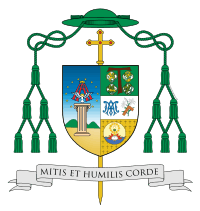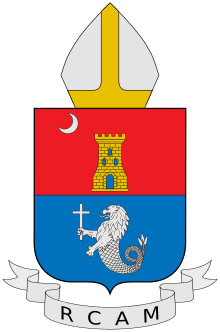Roman Catholic Diocese of Imus
The Diocese of Imus (Latin: Dioecesis Imusensis; Tagalog: Diyosesis ng Imus; Spanish and Chavacano: Diócesis de Imus) comprises the entire province of Cavite. The diocese was canonically erected on November 25, 1961, when it was excised from the Archdiocese of Manila.[1] Imus Cathedral, located along General Castañeda Street in the poblacion of Imus, serves as the see of the diocese. It is one of twelve cathedrals founded by the Order of Augustinian Recollects in the Philippines.
Diocese of Imus Dioecesis Imusensis Diyosesis ng Imus Diócesis de Imus | |
|---|---|
Our Lady of the Pillar Cathedral commonly known as Imus Cathedral was a current Espiscopal See of the Bishop of the Diocese of Imus. | |
| Location | |
| Country | |
| Territory | Cavite |
| Ecclesiastical province | Manila |
| Metropolitan | Manila |
| Statistics | |
| Area | 1,427.06 km2 (550.99 sq mi) |
| Population - Total - Catholics | (as of 2015) 3,678,301 2,512,560+ (76%) |
| Parishes | 85 |
| Churches | 100+ |
| Congregations | 150+ |
| Schools | 43 |
| Information | |
| Denomination | Catholic |
| Sui iuris church | Latin Church |
| Rite | Roman Rite |
| Established | November 25, 1961 |
| Cathedral | Cathedral of Our Lady of the Pillar (Imus Cathedral) |
| Patron saint | Our Lady of the Pillar |
| Secular priests | 189+ |
| Current leadership | |
| Pope | Francis |
| Bishop | Reynaldo G. Evangelista |
| Metropolitan Archbishop | Sede Vacante |
| Vicar General | George A. Morales |
| Bishops emeritus | Manuel C. Sobreviñas Bishop Emeritus (1993-2001) Luis Antonio Tagle Bishop Emeritus (2001-2011) |
| Website | |
| imusdiocese.weebly.com | |
The diocese is home to around 2,510,000 Roman Catholics spread across four episcopal districts, eleven vicariates, 80 parishes, three pastoral centers, a Catholic community, a national shrine (Our Lady of La Salette), and four were declared as diocesan shrines. There are 184 priests in the diocese, 95 of which are diocesan and 89 are religious.
In 2011, the Diocese of Imus celebrated the Golden Jubilee of its establishment. Activities were held within the diocese to mark the momentous event. Prior to the occasion, the celebration of the 5th Asian Youth Day in 2009 was also held in the diocese.
The diocese is under the patronage of the Virgin Mary under the title Our Lady of the Pillar, whose feast day is celebrated on October 12. The image of Our Lady was canonically crowned by Luis Antonio G. Cardinal Tagle, then Archbishop of Manila and homegrown Bishop of Imus, in a solemn ceremony held in 2012.
History
Through the zeal of the first missionaries of spreading the Catholic faith, they also helped in founding most of the towns of Cavite province. Among the religious orders that Christianized the Caviteños were the Franciscans, the Recollects, the Dominicans and the Jesuits. They established their first center of faith in Cavite Puerto (now Cavite City). The Catholic faith first came to Imus in 1571, then in Silang in 1581, in Cavite Viejo (now Kawit) in 1587, in Maragondon in 1611, Indang in 1655, Ternate in 1700 and in San Francisco de Malabon (now General Trias City) in 1758. As early as 1614, Cavite became a politico-military province.[2]
The province of Cavite is rich with historical significance. It had been the site of many battles and uprisings against Spain, one of which was that of 1872, which resulted in the execution of three priests: Gomez, Burgos and Zamora (Gomburza). Cavite is also where General Emilio Aguinaldo proclaimed the Philippine Independence from Spanish rule on June 12, 1898, in the town of Kawit.[2]
The province is named after its shape, that of a hook – hence Kawit, meaning hook, in Tagalog. It is geographically situated at the very entrance to Manila Bay, a location which has made it, along with Bataan on the north, the scene of many battles in the past. It is bounded on the northwest by the Bay, on the northeast by the provinces of Rizal and Laguna, on the southwest by the province of Batangas. Its capital city is Imus, with the seat of the provincial government located in Trece Martires City.[2]
Early in the American regime, a U.S. naval garrison was stationed at Sangley Point in Cavite City after a civil government was established in 1901. Because of mutual defense agreements, this base remained in Cavite long after the country was granted its independence in 1946.[2]
The topography of the province is gentle upward sloping towards the south, peaking in Tagaytay Ridge and Mts. Palay-Palay - Mataas-na-Gulod Range, at the border with Batangas province. Areas near the coast are flat where rice is an important crop. Fishing is another major industry in the coastal towns. The language spoken is Tagalog, which is the basis for Filipino, the national language of the country. More than 60 per cent of the inhabitants live in urbanized areas because of its proximity to Manila. Today, Cavite is witnessing a more radical urbanization as factories, subdivisions, golf courses, resorts and an Export Processing Zone (EPZA) have sprung up in the province. Tagaytay City, with its cool climate and a scenic view of Taal Lake and Taal Volcano, draws many tourists each year.[2]
The Diocese of Imus was created on November 25, 1961. It comprises the civil province of Cavite and covers a land area of 1,287 km2 (497 sq mi), with a population of 1,643,549 of which 76 per cent are Catholics. Its titular patroness is Nuestra Señora del Pilar. The diocese is a suffragan of the Archdiocese of Manila.[2]
On April 8, 2013, Reynaldo Gonda Evangelista was appointed by Pope Francis as the fifth bishop of Imus.[3] He is the first appointee of Pope Francis on the Catholic hierarchy of the Philippines.[4] He was installed last June 5, 2013.
Ordinaries
The list of the assigned bishops of the diocese since its establishment are as follows:[1]
| Coat of Arms | Name | From | Until | No. |
|---|---|---|---|---|
| Artemio G. Casas | December 11, 1961 | September 4, 1968 | 1 | |
| Felix P. Perez | February 25, 1969 | February 29, 1992 | 2 | |
| Manuel C. Sobreviñas | February 25, 1993 | October 22, 2001 | 3 | |
 | Luis Antonio G. Tagle | October 22, 2001 | October 13, 2011 | 4 |
 | Reynaldo G. Evangelista | June 5, 2013 | Incumbent | 5 |
Seminaries
Diocesan Seminaries
- Our Lady of the Pillar Seminary, Buhay na Tubig, Imus City, 4103 Cavite; Tel. (046) 686-1369
- Tahanan ng Mabuting Pastol Seminary, Mag-asawang Ilat, 4120 Tagaytay City; Tel. (046) 4131-329
Seminaries run by Religious Congregation
- Divine Word Seminary, SVD Rd., San Jose, 4120 Tagaytay City; Tels. (046); 4131-253; 413-0280
- Fr. Jordan Formation House, Salvatorian Fathers and Brothers, 189A Purok 3, Talon, Amadeo, 4119 Cavite; Tel. (046) 483-0734; Fax. (046) 483-0735
- La Salette College Seminary, National Shrine of Our Lady of La Salette, Biga, Silang, 4118 Cavite; Tels. (046) 414-2146; 414-0257
- Mission Society of the Philippines Seminary, SVD Road, Mag-asawang Ilat, 4120 Tagaytay City; Tel (046) 413-1381
- MSFS Formation House, Missionaries of St. Francis de Sales (MSFS), Lalaan I, Silang, 4118 Cavite, P.O. Box 041, Silang, Cavite; Tel. (046) 414-2360
- PIME Seminary, Pontifical Institute for Foreign Mission (PIME), Magallanes Drive, Sta. Rita, Silang Crossing West, 4120 Tagaytay City; Tel. (046) 413-3752
- San Pablo Theological Formation House, SVD Road, San Jose, 4120 Tagaytay City; Tel. (046) 413-1386
- San Ricardo Pampuri Formation House, Order of Hospitaller Brothers of St. John of God, Bo. Salaban, Amadeo, 4119 Cavite; Tel. (046) 413-1737
- Somascan Fathers Major Seminary, Sta. Rita, Kaybagal, 4120 Tagaytay City; Tel. (046) 413-1501
- St. Anthony's Boys Village - Cavite, Rogationists of the Heart of Jesus Km. 52 Aguinaldo Hi-way Lalaan 2, Silang, 4118 Cavite; Tel. (046) 414-0448
- St. Augustine Major Seminary (SASMA), Apostolic Vicariate of Calapan, SVD Road, San Jose, 4120 Tagaytay City; Tel. (046) 413-1319
- St. Gaspar Bertoni Seminary, Stigmatine Fathers & Brothers, Bo. Mabuhay, Carmona, 4116 Cavite; Tels.: (046) 430-1831; 430-2026
- St. Lawrence de Brindisi House of Studies, Our Lady of Lourdes Parish, 4120 Tagaytay City; Tel. (046) 413-1260
- St. Paul Seminary Foundation, Lalaan I, Silang, 4118 Cavite; Tel. (046) 414-2281
Golden Jubilee celebration
In 2011, the diocese celebrated its Golden Jubilee since its separation from the Archdiocese of Manila. The festivities centered on the theme "Tena't Mag-KA-RA-KOL" (Let's do the karakol), a pray-dance procession performed in fiestas in Cavite. The karakol spelled as KA-RA-KOL, is an acronym with "KA" for "KAhapong kay yaman" - an introspective look into the glorious history of the diocese; "RA" for "RAdikal na pagsunod kay Kristo," a call for reconciliation and conversion into the fullness of God's love by following the example of Jesus Christ; and "KOL" for "KOLektibong pagkilos," which envisioned a collective effort on the part of all Catholic faithful in the province to fulfill its mission of spreading God's word.
Prior to the jubilee year, a three-year preparation for the celebration (from 2009 to 2011) was led by then Bishop Luis Antonio Tagle, who was later appointed as the Archbishop of Manila. He led the opening of the jubilee year with a Mass celebrated at the patio of the Imus Cathedral on the midnight of the foundation day of the diocese, November 25, 2011. Among the highlights of the event was the opening of the cathedral's Jubilee Door. All the Catholic faithful who would pass through the door would be granted a plenary indulgence under the usual conditions. On October 16, 2012, a Mass for the celebration of the anniversary of the Cathedral's dedication was celebrated by Most Rev. Bishop Pedro Arigo D.D., then apostolic vicar of Puerto Princesa and a native of Kawit. The Grand Diocesan Procession was held on the streets of Imus after the Mass which featured the images of the patron saints of every parish in the Diocese.
On November 26, 2012, Mass and the closing of the Cathedral's Jubilee door was celebrated by Archbishop Rolando Tria Tirona Archbishop of Caceres and a native of Kawit. His concelebrants included Most Rev. Pedro Arigo D.D., Vicar of Puerto Princesa (also a native of Kawit), Most Rev. Manuel Sobreviñas, Bishop Emeritus of the Diocese of Imus, and Most Rev. Teodoro Buhain, Auxiliary Bishop-Emeritus of the Archdiocese of Manila and a native of Bacoor.
The solemn Canonical Coronation of the image of Our Lady of the Pillar of Imus, Patroness of the Diocese concluded the celebration of the Golden Jubilee. The Marian image was crowned by Luis Antonio Cardinal Tagle on December 3, 2012.
References
- "Diocese of Imus". Catholic-Hierarchy.org. David M. Cheney. Retrieved 21 January 2015.
- "Diocese of Imus". CBCP (Catholic Bishops' Conference of the Philippines) Online. Retrieved on 2013-05-10.
- "Other Pontifical Acts - Monday, April 8, 2013". Vatican Information Service. Retrieved on 2013-05-10.
- . GMA News Online. Retrieved 2013-04-08
